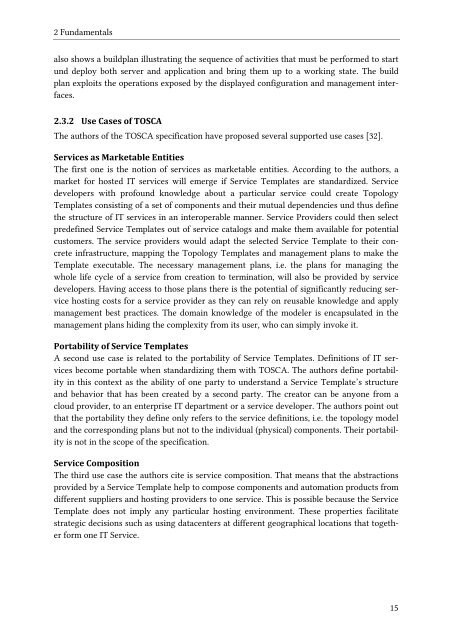Merging of TOSCA Cloud Topology Templates - IAAS
Merging of TOSCA Cloud Topology Templates - IAAS
Merging of TOSCA Cloud Topology Templates - IAAS
You also want an ePaper? Increase the reach of your titles
YUMPU automatically turns print PDFs into web optimized ePapers that Google loves.
2 Fundamentals<br />
also shows a buildplan illustrating the sequence <strong>of</strong> activities that must be performed to start<br />
und deploy both server and application and bring them up to a working state. The build<br />
plan exploits the operations exposed by the displayed configuration and management interfaces.<br />
2.3.2 Use Cases <strong>of</strong> <strong>TOSCA</strong><br />
The authors <strong>of</strong> the <strong>TOSCA</strong> specification have proposed several supported use cases [32].<br />
Services as Marketable Entities<br />
The first one is the notion <strong>of</strong> services as marketable entities. According to the authors, a<br />
market for hosted IT services will emerge if Service <strong>Templates</strong> are standardized. Service<br />
developers with pr<strong>of</strong>ound knowledge about a particular service could create <strong>Topology</strong><br />
<strong>Templates</strong> consisting <strong>of</strong> a set <strong>of</strong> components and their mutual dependencies und thus define<br />
the structure <strong>of</strong> IT services in an interoperable manner. Service Providers could then select<br />
predefined Service <strong>Templates</strong> out <strong>of</strong> service catalogs and make them available for potential<br />
customers. The service providers would adapt the selected Service Template to their concrete<br />
infrastructure, mapping the <strong>Topology</strong> <strong>Templates</strong> and management plans to make the<br />
Template executable. The necessary management plans, i.e. the plans for managing the<br />
whole life cycle <strong>of</strong> a service from creation to termination, will also be provided by service<br />
developers. Having access to those plans there is the potential <strong>of</strong> significantly reducing service<br />
hosting costs for a service provider as they can rely on reusable knowledge and apply<br />
management best practices. The domain knowledge <strong>of</strong> the modeler is encapsulated in the<br />
management plans hiding the complexity from its user, who can simply invoke it.<br />
Portability <strong>of</strong> Service <strong>Templates</strong><br />
A second use case is related to the portability <strong>of</strong> Service <strong>Templates</strong>. Definitions <strong>of</strong> IT services<br />
become portable when standardizing them with <strong>TOSCA</strong>. The authors define portability<br />
in this context as the ability <strong>of</strong> one party to understand a Service Template’s structure<br />
and behavior that has been created by a second party. The creator can be anyone from a<br />
cloud provider, to an enterprise IT department or a service developer. The authors point out<br />
that the portability they define only refers to the service definitions, i.e. the topology model<br />
and the corresponding plans but not to the individual (physical) components. Their portability<br />
is not in the scope <strong>of</strong> the specification.<br />
Service Composition<br />
The third use case the authors cite is service composition. That means that the abstractions<br />
provided by a Service Template help to compose components and automation products from<br />
different suppliers and hosting providers to one service. This is possible because the Service<br />
Template does not imply any particular hosting environment. These properties facilitate<br />
strategic decisions such as using datacenters at different geographical locations that together<br />
form one IT Service.<br />
15
















